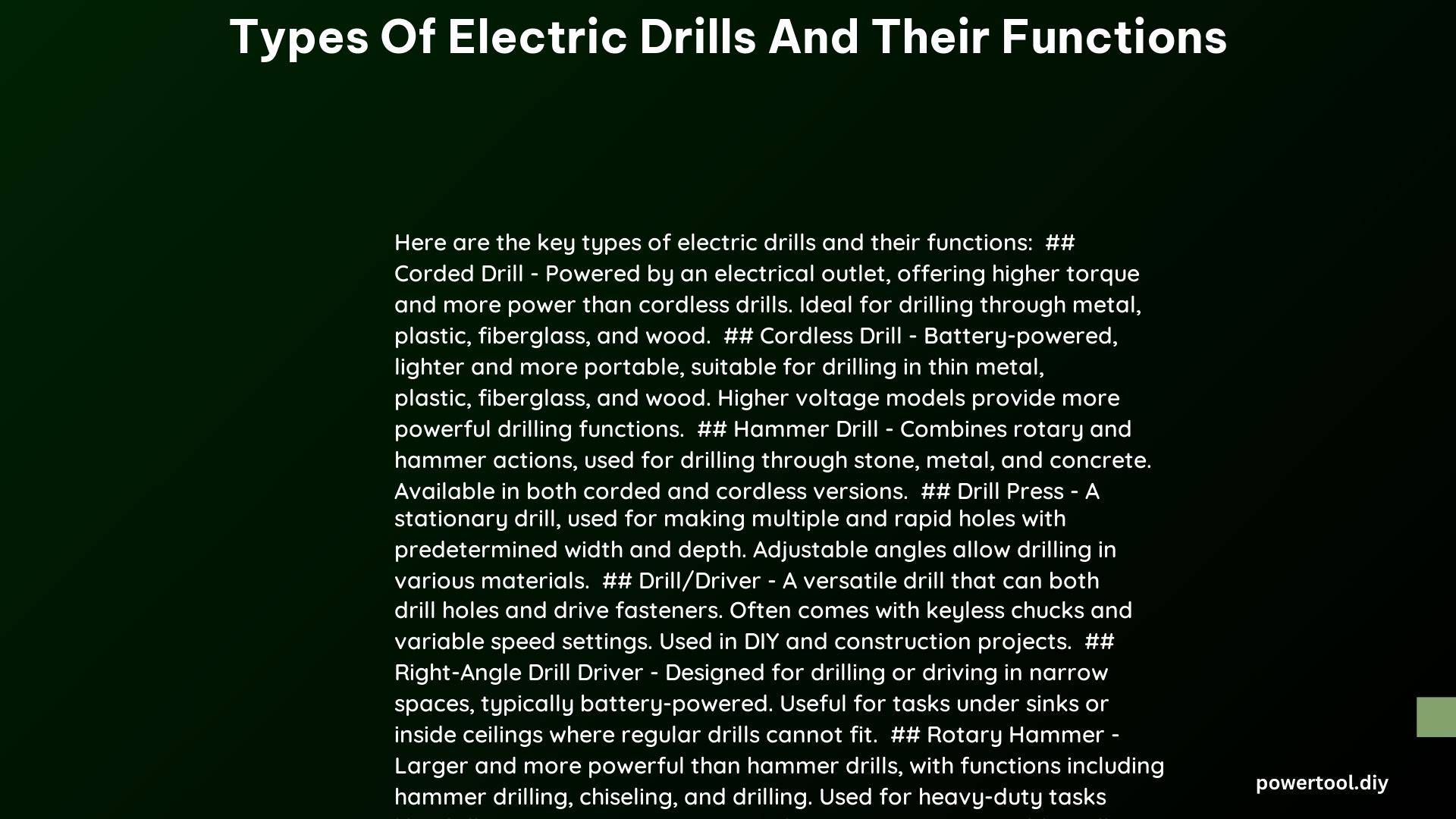Electric drills are versatile power tools essential for various tasks, from DIY projects to professional construction work. They come in different types, each designed for specific functions and applications. This comprehensive guide explores the main types of electric drills, including cordless drills, hammer drills, regular drills, variable speed drills, impact drivers, and impact wrenches. Understanding their unique features and functions helps in selecting the right tool for your specific needs.
What Are the Main Types of Electric Drills?
Cordless Drills
- Function: Portable drilling and fastener driving
- Power Source: Rechargeable batteries (Li-ion or NiCd)
- Key Features:
- Keyless chuck
- Adjustable speed settings
- Battery life: 2-8 hours (depending on usage)
- Charge time: 30 minutes to 2 hours
Hammer Drills
- Function: Drilling into hard materials like concrete and masonry
- Unique Feature: Combined rotary and hammering action
- Applications: Construction and masonry work
Regular Drills (Drill/Drivers)
- Function: General drilling and fastener driving
- Materials: Wood, metal, plastic
- Key Feature: Constant rotary force
Variable Speed Drills
- Function: Precision drilling and fastener driving
- Key Feature: Adjustable speed settings
- Advantage: Versatility across different materials and tasks
Impact Drivers
- Function: Driving large screws and bolts
- Key Feature: High torque output (100-200 ft-lbs)
- Applications: Construction and automotive repair
Impact Wrenches
- Function: Loosening or tightening large bolts and nuts
- Key Feature: Highest torque output (200-1000+ ft-lbs)
- Applications: Heavy-duty automotive and industrial tasks
How Do Cordless Drill Batteries Perform?

Battery Types and Performance
| Battery Type | Energy Density | Cycle Life | Self-Discharge Rate |
|---|---|---|---|
| Li-ion | Higher | Longer | Lower |
| NiCd | Lower | Shorter | Higher |
Factors Affecting Battery Longevity
- Usage patterns (avoid deep discharges)
- Storage conditions (avoid extreme temperatures)
- Charging practices (use correct charger, avoid overcharging)
What Are the Differences Between Hammer Drills and Regular Drills?
Comparison Table
| Feature | Hammer Drill | Regular Drill |
|---|---|---|
| Torque | Higher | Lower |
| RPM Range | 500-2000 RPM | Up to 3000+ RPM |
| Impact Rate | Up to 30,000 BPM | N/A |
| Optimal Use | Concrete, masonry, brick | Wood, metal, plastic |
Why Are Variable Speed Drills Advantageous?
- Precise RPM Adjustments: Tailored to specific materials
- Enhanced Control: Improved accuracy in drilling and fastener driving
- Versatility: Suitable for various applications, from delicate tasks to heavy-duty drilling
How Do Impact Drivers Compare to Impact Wrenches?
Key Differences
- Torque Output:
- Impact Drivers: 100-200 ft-lbs
- Impact Wrenches: 200-1000+ ft-lbs
- RPM:
- Impact Drivers: Higher RPM, optimized for fastener driving
- Impact Wrenches: Lower RPM, higher impact rates for high-torque applications
- Primary Applications:
- Impact Drivers: Construction, DIY projects
- Impact Wrenches: Automotive repair, heavy construction
What Should You Look for in an Electric Drill for Home Use?
Ideal Specifications
- Power Output: 300-500 watts
- Weight: 3-5 lbs
- Noise Levels: 80-90 dB
- Vibration Ratings: 10-20 m/s²
Recommended Models
- DeWalt DCD996B Hammer Drill
- Brushless motor
- 20V battery
- Adjustable speed settings
-
Suitable for various tasks, including concrete drilling
-
Makita XFD10R 18V Cordless Drill
- Compact design
- Brushless motor
- Long-lasting battery
- Ideal for general household drilling and driving tasks
By understanding the types of electric drills and their functions, you can choose the most suitable tool for your specific needs, whether for DIY projects, professional construction work, or general household tasks.
